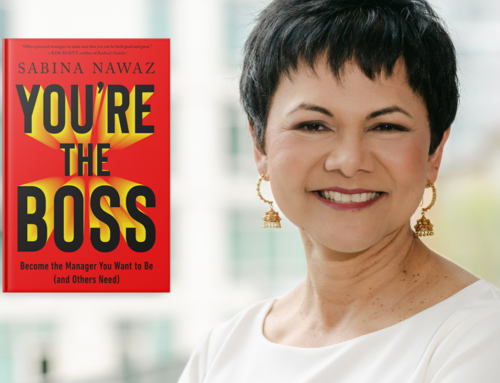It’s a great pleasure to catch up with Ron Tite and learn about his new book, Think Do Say. Ron is the founder of Church+State, a content marketing agency, an executive producer and host of the podcast, “The Coup” (Rogers Frequency), publisher of the award-winning humor book, This is That Travel Guide to Canada, co-author of Everyone’s an Artist (Harper Collins, 2016) and author of Think Do Say: How to Seize Attention and Build Trust in a Busy, Busy World (Page Two, 2019). He’s a funny, smart guy and an engaging speaker.
Nick: Ron, please tell us about your experiences working with companies that led to Think Do Say.
Ron: I’ve had a few unique paths that inspired and informed this book. I spent years as a writer and creative director at a global ad agency working with global brands. When it comes to business creativity, I was in the belly of the beast – not just trying to create attention-worthy work but also trying to convince others that they should approve it.
In one career, I lived the glory years of TV and print, the chaotic transition to digital, the always-on content crank machine of social media, and the complete and total disruption of the industry and business model. I have some marketing scars but I’m proud of what went into earning them.
I also spent over 20 years as a professional comedian, 10 years as a professional speaker, and 8 years ago, finally scratched my lifelong entrepreneurial itch and started my own agency, Church+State.
Whether it’s on stage, in a boardroom, on TV, or on a mobile device, there has always been one constant: To build a lifelong and fulfilling career or business, you have to be interesting enough to get their attention and good enough to sustain it.
Nick: How can people in the midst of trying to develop authentic, convincing messages recognize their own blind spots and get to the heart of what they’re doing?
Ron: Oh, sure. NOW you ask. This is such a great question and I wish I had covered it more in the book. Here’s the thing: We all have blindspots. So let’s start there. Blindspots are so much easier to recognize when you admit that they’re going to be there – you just keep exploring until you identify them. But if you think you don’t have them, you probably won’t see them. Let’s face it, if you want to poke holes in your messaging, you have to initiate the poking.
Secondly, it’s important to realize that blindspots are both functional and emotional in nature. We have functional blindspots because we can’t see the reality of what we do. We have emotional blindspots because we don’t want to see the reality of what we do.
Overcoming Functional Blindspots: I think my biggest responsibility as a consultant is to protect clients from themselves. They can’t see their weakness because they’re too close to it. My job is to see the things they can’t, call them out on their BS, and provide the fresh perspective they need.
I’m outside counsel.
To identify functional blindspots, we all need honest and trusted advisors to point them out. Where none exist, we need an iterative process that lets us identify our blindspots through repeated delivery. In my comedic life, I never ask for anyone’s opinion. I discover what works and what doesn’t by repeatedly trying it out on stage. Over and over and over and over. The audience shows me where the blindspots are. I pan for silver but work for gold.
Overcoming Emotional Blindspots: There’s a part of you that doesn’t want to see your imperfections because it’s a blow to the ego to find out that the thing you thought was brilliant, well, isn’t. It’s not that we’re incapable of seeing it. It’s that we’re afraid to see it. It creates self-doubt, generates a bit of imposter syndrome, and makes us question how we can possibly claim to be a professional in the first place.
There’s only one solution (IMHO): The total and blatantly obvious understanding that you’re not special. You’re not. And since you’re not special, you have to try. And trying is work. Getting to the bottom of what works and what doesn’t work – for those who aren’t lucky enough to have been born absolute geniuses – is work. If you’re the pro you claim to be, do the work that comes with the territory.
Nick: In the book, you contrast good and bad messaging to great effect. Are there some good ways to fix bad messaging, or is it better to just throw everything out and start over?
Ron: Not every renovation requires a total destruction of the property. Haven’t you seen any of those home design shows? Sometimes, all you need is a coat of paint and an Ikea print above the couch before you say, “Move that bus!”. Other times, the house may look ok but everyone knows the foundation is weak. You certainly shouldn’t assume that you’ll need to bring in a wrecking ball to your messaging but taking a peak at the foundation is probably a good place to start. If you can fix the foundation to your messaging – the structure, beliefs, framework, and walls – you can still include some of the best bits and insights that still apply.
Words matter. Specific words matter. Exact phrases and cadence and tone all matter.
Great messaging is the most nuanced choices applied to a solid framework.
Move that bus!!
Nick: Can a good marketing message/campaign only be designed in retrospect (after thinking and doing) or can it lead the way?
Ron: I was very intentional with the order of “Think Do Say” because in my experience, far too many people and organizations declared their aspirations as if the actions to support them were already in place. That results in an integrity gap between what was expected and what was delivered – even if that happens in a brief transition period between old and new. It might just create the equivalent of a customer paper cut, but it still affects long term trust.
That being said, a couple of specific choices can be made to make it work. Phrases like, “Here’s what we’re working on”, or “Here’s what we will do over the next 6 months”, are not only honest and transparent, they’re effective. When you give people a backstage pass, they like they’re feel part of the process. You’re giving them a sneak peek and normally, only special people get sneak peeks.
So, yea. Campaigns can lead the way. Word of warning: If you tell people what you’re going to do and then you don’t do it? That’s worse than having never said it at all.
Nick: Finally, tell us about Ron — what do we need to know about you?
Ron: I’m writing this one day after announcing something interesting. When I started my agency, Church+State, I wanted to combine robust thought leadership with smart consultation and creative application. I wanted to spend my time creating – products, business models, partnerships, and content. As our team and clients know, I’ve been focused on this for a while. I may have been CEO in title but not in function. It seems my “DO” wasn’t lining up with my “SAY”.
Yesterday, we changed that.
I officially stepped down from my role as CEO, promoted my President to CEO and our EVP Strategy to Chief Strategy Officer. I’m still very much a part of the agency but I want to do it speaking, writing, and pursuing interesting products and partnerships away from the daily rigors of important client work.
The Pursuit of Happiness shouldn’t just be a Hollywood movie or a Canadian band from the 80’s. My wife and I have a 21-month-old son (Max!) and a second child due in March (No Name!). I know #Blessed is somewhat of an eye-roll inducing expression these days but I am truly grateful for the special people and experiences in my life.
Nick: Ron, thanks – and keep up the amazing work.









Leave A Comment